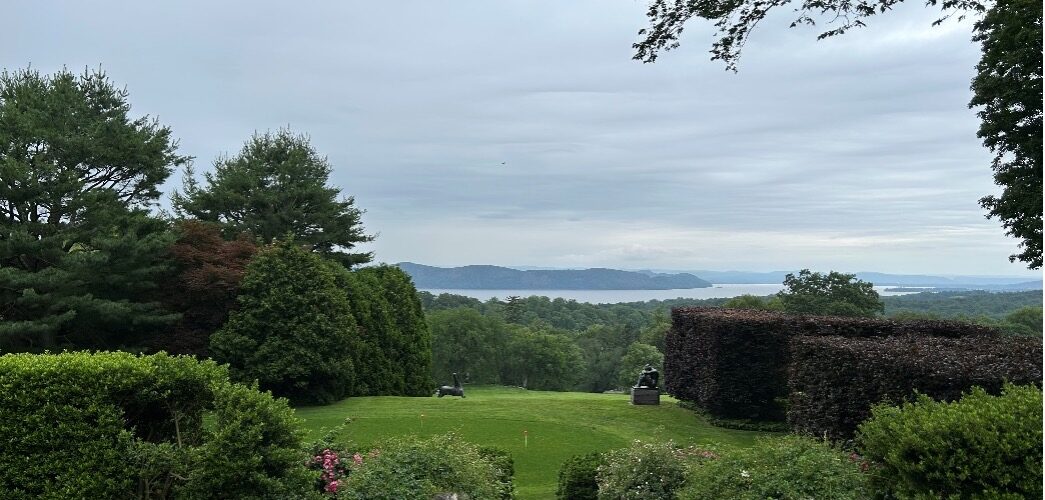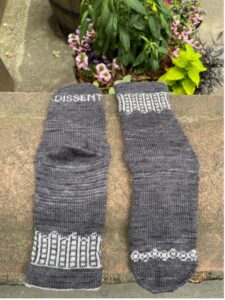Weaving the River of Time
August 21, 2025 - By Donita Volkwijn
I was sitting with my sister and friend one evening, and they were talking about the socks she had knit for him a few years ago.
“Are they still holding up?” she asked.
“They are,” he responded, “although they may need to be darned in a few places.”
“Give them to me. It’s much easier to darn them when they’re getting thin. Once there’s a hole, it becomes much more complicated.”
Friends, the socks of our society are wearing thin and developing holes.
In mid-June, I was honored to facilitate a workshop as part of a Foresight & Futures Initiative Beehive, conceived by the brilliant Olga Tarasov of Rockefeller Philanthropy Advisors. The Beehive is a part of a two-year global community of practice that aims to help philanthropy institutionalize best practices offered by the disciplines of foresight and futurism.
My workshop on community building was the second facilitated offering of the day. It followed Shermon Cruz’s ceremony, invoking the spirit of rivers, with their call to listen. I, in turn, was followed by Nikolas Badminton’s exhortation to follow the wild idea of building a business on the foundation of hope.
Listening…community…hope. It felt, at times, like we had been plucked out of the information superhighway and placed in a river of tranquility.
Shermon asked us to find ourselves in the river and to find the river in us. “Ko au te awa, ko te awa ko au.” (Māori proverb: I am the river, the river is me). If you’ve spent an afternoon with a river, you understand how time can stand still as you sit on its banks. But with its cyclical nature furthered by over-industrialization, the river can also overflow its banks and destroy everything around it, erasing time as easily as doodles in the sand.
And hope. Oof, hope can be brutal. There’s a reason she lived in Pandora’s box with all of the other evils of the world. Nikolas, however, challenged us to embrace hope, not by ignoring the other denizens that inhabited the box, but by facing them head-on, with hope as that gritty destroyer at our side. Hope is not meant to be a panacea for daydreamers who can only see her as a soft little thing they can hide behind as the world burns. She is fierce and traumatized after existing alongside horrors for eons; she wears her survival as a battered badge of honor.
If we go back to the sock-as-society metaphor, the community component reveals itself as well. Many of us have learned the importance of working together to tend to the spots that weaken under pressure and need care. We sit at the feet of those who went before us and teach the patterns to those who come after us. We ensure that fundamentals are grasped before we encourage innovation, trusting others to do the same in spots we can’t see. We evolve by sharing wisdom, and in normal circumstances, that would be more than enough.
But these are not normal circumstances.
As greed and power become the new currency, there are some who are actively cutting through the knits and purls that hold the fabric of our society together, creating holes that threaten the integrity of the structure entirely. They seek to use those cut threads as a means to blind, deafen, and silence us to the deliberate cruelty of genocide, mass deportation, revocation of civil and reproductive rights, and a playbook meant only for them. Because they, too, have sat and learned at the feet of their elders, cowardice and greed.
So what do we do?
As my sister and any other master craftsperson will tell you, there’s a point at which even the most loved thing cannot be repaired. A moth-eaten sock that chafes and disintegrates serves neither the maker nor the wearer, and if I were to ask her advice on what to do next, her answer would be rather simple.
“It’s time to knit something anew.”
The longer we’ve tended to and loved something, however, the more difficult it can be to bid it farewell. If we were to listen to greed and cowardice, we might be convinced that our resources are too scarce to create something new. That we need to hold on to scraps, because that’s all we have and all we deserve. If, however, we use the model of rivers, hope, and community and tend to them with love, we create abundance that allows us time to examine what’s around us. What if we’ve been using our energy to reweave a failing sock when what we really needed was a scarf?
Yes, we’re standing on a precipice. But we’re also standing at the origin of infinite possibility. We have an embarrassment of resources if we look up from our freneticism and pause. The world today holds minds and people and ideas that could never have been imagined only 100 years ago. It holds rivers. It holds community. It holds hope.
As we build a future we haven’t yet imagined, we can add to the Māori proverb:
I am the river, the river is me
I am the community, the community is me
I am hope, hope is me
(“Dissent” socks knit by Lynne-Corinne Volkwijn after a pattern created by Tiina Kuu)
My gratitude to all of the participants of past and future Beehives, as well as to those without whom they couldn’t happen: Caroline Suozzi, Lillian Wambui Chege, and Victoria Martinez. Thank you also to the staff at The Pocantico Center for creating a space for imagining.
The views expressed here are my own and do not reflect the views of my employer or any affiliated organizations.
Back to News

